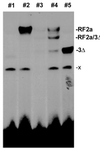Transcription factor RF2a alters expression of the rice tungro bacilliform virus promoter in transgenic tobacco plants
- PMID: 11390974
- PMCID: PMC34720
- DOI: 10.1073/pnas.121186398
Transcription factor RF2a alters expression of the rice tungro bacilliform virus promoter in transgenic tobacco plants
Abstract
The promoter from rice tungro bacilliform badnavirus (RTBV) is expressed only in phloem tissues in transgenic rice plants. RF2a, a b-Zip protein from rice, is known to bind to the Box II cis element near the TATA box of the promoter. Here, we report that the full-length RTBV promoter and a truncated fragment E of the promoter, comprising nucleotides -164 to +45, result in phloem-specific expression of beta-glucuronidase (GUS) reporter genes in transgenic tobacco plants. When a fusion gene comprising the cauliflower mosaic virus 35S promoter and RF2a cDNA was coexpressed with the GUS reporter genes, GUS activity was increased by 2-20-fold. The increase in GUS activity was positively correlated with the amount of RF2a, and the expression pattern of the RTBV promoter was altered from phloem-specific to constitutive. Constitutive expression of RF2a did not induce morphological changes in the transgenic plants. In contrast, constitutive overexpression of the b-ZIP domain of RF2a had a strong effect on the development of transgenic plants. These studies suggest that expression of the b-Zip domain can interfere with the function of homologues of RF2a that regulate development of tobacco plants.
Figures






Similar articles
-
Essential role of the Box II cis element and cognate host factors in regulating the promoter of Rice tungro bacilliform virus.J Gen Virol. 2006 Mar;87(Pt 3):715-722. doi: 10.1099/vir.0.81488-0. J Gen Virol. 2006. PMID: 16476995
-
RF2a, a bZIP transcriptional activator of the phloem-specific rice tungro bacilliform virus promoter, functions in vascular development.EMBO J. 1997 Sep 1;16(17):5247-59. doi: 10.1093/emboj/16.17.5247. EMBO J. 1997. PMID: 9311985 Free PMC article.
-
RF2b, a rice bZIP transcription activator, interacts with RF2a and is involved in symptom development of rice tungro disease.Proc Natl Acad Sci U S A. 2004 Jan 13;101(2):687-92. doi: 10.1073/pnas.0307687100. Epub 2004 Jan 2. Proc Natl Acad Sci U S A. 2004. PMID: 14704272 Free PMC article.
-
Functional analysis of RF2a, a rice transcription factor.J Biol Chem. 2003 Sep 19;278(38):36396-402. doi: 10.1074/jbc.M304862200. Epub 2003 Jul 10. J Biol Chem. 2003. PMID: 12855676
-
Rice TATA binding protein interacts functionally with transcription factor IIB and the RF2a bZIP transcriptional activator in an enhanced plant in vitro transcription system.Plant Cell. 2002 Apr;14(4):795-803. doi: 10.1105/tpc.010364. Plant Cell. 2002. PMID: 11971135 Free PMC article.
Cited by
-
Downstream promoter sequence of an Indian isolate of Rice tungro bacilliform virus alters tissue-specific expression in host rice and acts differentially in heterologous system.Plant Mol Biol. 2007 Oct;65(3):259-75. doi: 10.1007/s11103-007-9214-3. Epub 2007 Aug 26. Plant Mol Biol. 2007. PMID: 17721744
-
Functional characterization of the Arabidopsis transcription factor bZIP29 reveals its role in leaf and root development.J Exp Bot. 2016 Oct;67(19):5825-5840. doi: 10.1093/jxb/erw347. Epub 2016 Sep 22. J Exp Bot. 2016. PMID: 27660483 Free PMC article.
-
The large intergenic region of Rice tungro bacilliform virus evolved differentially among geographically distinguished isolates.Virus Genes. 2012 Apr;44(2):312-8. doi: 10.1007/s11262-011-0680-y. Epub 2011 Oct 12. Virus Genes. 2012. PMID: 21989904
-
Long terminal repeats (LTR) and transcription factors regulate PHRE1 and PHRE2 activity in Moso bamboo under heat stress.BMC Plant Biol. 2021 Dec 9;21(1):585. doi: 10.1186/s12870-021-03339-1. BMC Plant Biol. 2021. PMID: 34886797 Free PMC article.
-
Transgenic rice plants that overexpress transcription factors RF2a and RF2b are tolerant to rice tungro virus replication and disease.Proc Natl Acad Sci U S A. 2008 Dec 30;105(52):21012-6. doi: 10.1073/pnas.0810303105. Epub 2008 Dec 22. Proc Natl Acad Sci U S A. 2008. PMID: 19104064 Free PMC article.
References
Publication types
MeSH terms
Substances
LinkOut - more resources
Full Text Sources
Other Literature Sources

